CLICK ME
Menu
The commercialization of culture: How Carla Cammilla Hjort turned creativity into a business
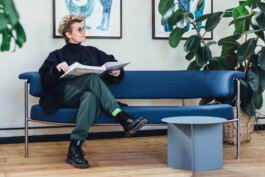
What makes Carla Cammilla Hjort a force of nature? She has led the creation and development of Space10, IKEA’s groundbreaking innovation lab in Copenhagen. She has founded and continues to run Art Rebels, an international collective of creators and artists with an in-house agency that is leading innovation for companies on a global scale. As a pillar of the cultural scene in Copenhagen, she has arranged parties, festivals, and gatherings since forever, and been the driving force behind an influx of creative minds and souls moving to Denmark to take part in her ever-evolving communities.
I’m excited to talk to you today, Carla, thanks for taking the time. You are among those in Copenhagen who make the city tick, but before we get down to the nitty- gritty of how you do it, I would like to ask you a bit about your background. What were you like in your formative years?
“I went to high school in Gentofte outside Copenhagen after I came back to Denmark from Philadelphia where I’d lived and studied. Initially, I just wanted to get it over with and get back to the US as quickly as possible, but I met a guy, Christian, and we quickly became friends. We shared a passion for writing and for studying philosophy. He introduced me to two pivotal things: Nietzsche’s Thus Spoke Zarathustra and drugs. Philosophy, LSD, and mushrooms turned my life upside down, and I realized I had to reconsider my entire life: Who I was? What did I want to spend my life on?”
But you finished high school?
“Yes, I’ve always been a good student. But a year before I turned 18, I inherited some money from my granddad that made it possible for me to do something else than follow the road already taken. And instead of following my plan of going back to America, I planned a trip around the world and bought 28 plane tickets.”
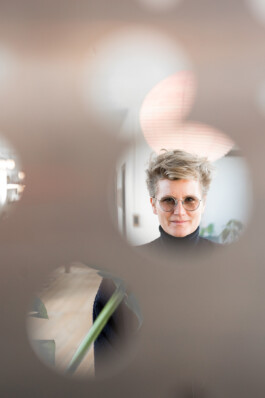
“Meditation has taught me to keep a healthy distance between what I am and what I do.”
– Carla Cammilla Hjort
For how long did you travel for?
“At first, I thought it would be for a year, and then I’d go back to Denmark or the USA to study. But after the first year, I still hadn’t found out who I was or why I was here, so I ended up traveling for 3.5 years in total. During my trip, I was introduced to the Indian philosopher Osho, and stayed in his ashram for a full year, and this became a seminal experience for me. After a year, I felt courageous in a completely new way. From there on, I knew that I was capable of going my own ways, and I also ultimately parted with the idea of pursuing an academic career.”
How exactly did you grow personally?
“I learned what courage is. I learned to be well-balanced, and I understood my limits. I found a passion and my personal strengths. I learned that I was able to run multiple projects without losing focus or becoming stressed. Meditation became a crucial element in my journey.”
What did it do?
“Meditation has taught me to keep a healthy distance between what I am and what I do. And to not identify myself with my thoughts. And also to get the most out of who I am and life in general. It’s very fluid how it morphs.”
So I guess the outline of your real career began to form after you returned?
“Yes, when I came back I started at the European Film College in Ebeltoft, thinking that telling stories was a way forward. However I had to realize that film was not my calling. I needed more variety. But studying there I realized one career defining thing: I was really good at getting ideas, and leading and assembling a team. When I was done with film school I did a few things for DR (Danish Broadcasting Corporation) and I also DJ’ed, and it literally took me less than three months before I found I could live off it. I thought to myself: Wait a minute, I know how to transform what I know into something of value for others. Something that they are willing to pay for.”
That’s quite the skill.
“I began to notice how many talented friends I had around me. And how hard it was for some of them to monetize their work. I began to see myself as a facilitator and concept developer, so that the people around me could make a living from what they did. I knew how to orchestrate that. And that turned into ArtRebels in 2006.”
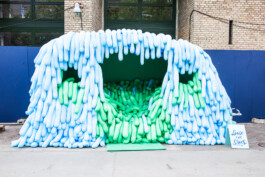
I remember ArtRebels from when I first moved to Copenhagen, and how the idea of a creative community was appealing for a person like myself who had just arrived in the big city. Tell me about the first years.
“ArtRebels was and still is a community. A network of talents from basically every creative discipline. It started locally here in Copenhagen but grew into a global movement. To nurture the community, I founded Trailerpark Festival, a gathering about art, music, and design driven by artistically social beings. At the same time, ArtRebels also worked as a modern creative agency with a small, core team, like today, where we are really good at developing concepts and strategies that aims to bring a positive change to society and then build the bridge between corporate life and the network of creative freelancers.”
I remember you also had a webshop that was quite advanced at the time being?
“Yes. In 2007/08, e-commerce was just taking off on the back of blogs, so we built a pretty advanced Etsy-inspired model from scratch. We sold music, film, books and artworks, and I ended up spending a ton of money on it. We never turned any profit from it, but we learned quite a lot and it helped build our community, but after six years I decided to close it and fully commit ourselves to the agency part of ArtRebels. It was around that time that IKEA showed up.”
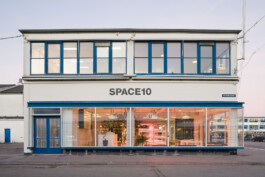
It’ is no secret that IKEA has played a vital role in Carla’s professional life over the last 6–7 years. She was invited by IKEA Sweden’s CEO Torbjörn Lööf to give a keynote when the executive team visited Copenhagen. The team was on a three day inspirational trip, and Carla spoke about her two brainchilds: ArtRebels and Trailerpark Festival. The chemistry was good, and after the keynote, Carla was asked what she would do if she had free reign to create anything in collaboration with the Swedish mastodont.
And what did you suggest?
“A limited collection for people living in small spaces with an ArtRebels touch and feel. Five days later, Torbjörn sent me a mail. My keynote had been the most inspiring part of their trip, and my suggestion aligned perfectly with their new strategy. He wanted to make it happen. He put me in touch with their former Head of Design, Marcus Engman. And less than a month later, we had a contract for ArtRebels to do a global collaboration with them.”
Wow!
“Right. I’d never made an easier pitch in my life. And it became the beginning of a new era for me. It was a great success and created lots of hype, and the collection sold out in all markets after just two months.”
A pretty good starting point for future collaboration, I guess. What happened then?
“A year and a half went by, and one day Torbjörn called me from the airport. He was in New York, and had been in meetings all week. He told me he had been thinking about the last time we met. He had since been promoted to be the CEO of Inter IKEA Systems, the global owner of the concept, brand, and franchise. “I want to design a better IKEA for the future,” he said. “And I thought about you. I don’t have any plan or agenda, I just want to put it out there. You can think about it and get back to me if you have any ideas.”
That escalated quickly.
“I was like, ‘“Wow! What just happened!?’” And I thought to myself: The first time I pitched an idea to this man he bought it instantly. Now I have to really think about what I want to do. What would be the ultimate idea to pitch if I had access to IKEA’s resources and funds to design for a better future?”
You came up with the idea of Space10, obviously. But what was the process?
I contacted an old colleague, Simon Caspersen, who later went on to be Communications Director at Space10, to help me with the pitch. After a few weeks, we came up with the idea of not pitching ideas to IKEA per se, but instead to pitch them the model of how we would generate ideas and work with ideas. Plus, I was hugely motivated by their vision: “To create a better everyday life for the many people.”
With an idea for an external innovation lab ready to be pitched, Carla and Simon got in touch with Torbjörn Lööf and told him they were ready to present in Delft in The Netherlands, where Inter IKEA Systems is headquartered. Carla and Simon brought 12 slides with hardly any text, only models, and had six hours to pitch.

So how did it go?
“Torbjörn had invited a small group of his colleagues to the pitch. The chemistry was good, but I had a hard time reading one of the guys, Michael, who just sat there stone-faced. After some time, he stopped me and said: ‘“Listen, I would normally never say this in front of you, but I need to say something.’” Oh no, I thought. ‘“This is the most inspiring pitch I’ve ever seen.’” After that, everyone followed and the vibe in the room became more or less ecstatic. My plan was to tell my own very personal story, complete with my use of psychedelic drugs, that I had no education, to spice it up a bit. And then get to explain what ArtRebels and Trailerpark were. Simon, on the other hand, pitched in with his own personal story. He has a double Master’s Degree, which worked great as my contrast. It turned into a really good and honest sharing session, and I think it created quite a unique experience for all of us and definitely made it the most interesting pitch I’ve ever been involved in.”
They settled on the idea. IKEA loved it. And after the finances were agreed upon, and they could add a few more people to the
team, Space10 was a reality. In the beginning, they were four. Today, it’s an organization of 32 creative thinker-doers with a global outreach and a constant feed of executable ideas that are tested and tried before being implemented into IKEA.

You stepped down as the CEO and became Vision Director instead. What happened?
“I’m really good at getting ideas, setting the vision, building teams and motivating people. But when a team grows beyond 15 people it seems like my natural lack of structure becomes a challenge. Also it became clear to me that everything we did became more and more digitally driven and that’s not my strongest asset.”
Did you realize that yourself, or did you need a push in the right direction?
“We were four years in before I made my first executive decision. I brought in a psychologist to support the core managing team to take us to the next level. We had individual sessions followed by group sessions. After those sessions the psychologist told me that he thought Kaave (Pour, ed.) was ready to take over and I should consider that scenario. I’ve known Kaave since he was 17 and always seen him as an extremely talented guy with a natural talent for leading. I asked him, and he was ready. And within 24 hours, the decision was made. We had full support from IKEA to restructure.”
That’s a massive transformation, and I guess also a very challenging period of time for you personally. How did you handle it?
“I knew that I would have to hand over Space10 one day, but I’d imagined it would be three years later than it came to be. It was a massive decision that affected me deeply. I was, however, really happy to see Kaave step up as CEO. And to let him fill out him role and not to confuse the team from the transition, I stayed at home for three months where my state of mind switched between epiphanies and identity crises.”
What did you do?
“I began to read philosophy again. And I slowly realized that I still had ArtRebels, an agency with the abilities to basically do the same as Space10 does, but for other companies than IKEA.”
That’s quite a market.
“Yes, SPACE10 became such a success that landing new clients is no longer a struggle. I have a new, amazing team in place and a new location, and we work hard at bringing ArtRebels to its full potential.”
Subscribe
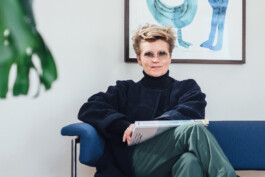
I think you’ve been extremely good at showcasing the value of small communities to global corporations, and building bridges between the two. The commercialization of creative talent is not to be underestimated.
“It’s also one of the things that I’m most proud of: To be able to value creative talent and get buy-in. There seems to be a general belief that creatives have more fun, and therefore shouldn’t be paid that much for their work. For the first five years of ArtRebels I did not know how to value our work properly, and I was also learning to become a business woman. But I’ve fine-tuned my skills and also grown a lot from experience. Today I know what our method is worth and the value we bring to our clients. I love learning and feel very fortunate to have managed getting us this far”
Headlight Journal is published by Headlight. We deeply want to change people’s approach to work forever, and we’re eager to connect with like minded think-doers who have decided that there’s room for improvement. If you want to know how Headlight can play a role in your working life, do not hesitate to get in touch.
The commercialization of culture: How Carla Cammilla Hjort turned creativity into a business

What makes Carla Cammilla Hjort a force of nature? She has led the creation and development of Space10, IKEA’s groundbreaking innovation lab in Copenhagen. She has founded and continues to run Art Rebels, an international collective of creators and artists with an in-house agency that is leading innovation for companies on a global scale. As a pillar of the cultural scene in Copenhagen, she has arranged parties, festivals, and gatherings since forever, and been the driving force behind an influx of creative minds and souls moving to Denmark to take part in her ever-evolving communities.
I’m excited to talk to you today, Carla, thanks for taking the time. You are among those in Copenhagen who make the city tick, but before we get down to the nitty- gritty of how you do it, I would like to ask you a bit about your background. What were you like in your formative years?
“I went to high school in Gentofte outside Copenhagen after I came back to Denmark from Philadelphia where I’d lived and studied. Initially, I just wanted to get it over with and get back to the US as quickly as possible, but I met a guy, Christian, and we quickly became friends. We shared a passion for writing and for studying philosophy. He introduced me to two pivotal things: Nietzsche’s Thus Spoke Zarathustra and drugs. Philosophy, LSD, and mushrooms turned my life upside down, and I realized I had to reconsider my entire life: Who I was? What did I want to spend my life on?”
But you finished high school?
“Yes, I’ve always been a good student. But a year before I turned 18, I inherited some money from my granddad that made it possible for me to do something else than follow the road already taken. And instead of following my plan of going back to America, I planned a trip around the world and bought 28 plane tickets.”

“Meditation has taught me to keep a healthy distance between what I am and what I do.”
– Carla Cammilla Hjort
For how long did you travel for?
“At first, I thought it would be for a year, and then I’d go back to Denmark or the USA to study. But after the first year, I still hadn’t found out who I was or why I was here, so I ended up traveling for 3.5 years in total. During my trip, I was introduced to the Indian philosopher Osho, and stayed in his ashram for a full year, and this became a seminal experience for me. After a year, I felt courageous in a completely new way. From there on, I knew that I was capable of going my own ways, and I also ultimately parted with the idea of pursuing an academic career.”
How exactly did you grow personally?
“I learned what courage is. I learned to be well-balanced, and I understood my limits. I found a passion and my personal strengths. I learned that I was able to run multiple projects without losing focus or becoming stressed. Meditation became a crucial element in my journey.”
What did it do?
“Meditation has taught me to keep a healthy distance between what I am and what I do. And to not identify myself with my thoughts. And also to get the most out of who I am and life in general. It’s very fluid how it morphs.”
So I guess the outline of your real career began to form after you returned?
“Yes, when I came back I started at the European Film College in Ebeltoft, thinking that telling stories was a way forward. However I had to realize that film was not my calling. I needed more variety. But studying there I realized one career defining thing: I was really good at getting ideas, and leading and assembling a team. When I was done with film school I did a few things for DR (Danish Broadcasting Corporation) and I also DJ’ed, and it literally took me less than three months before I found I could live off it. I thought to myself: Wait a minute, I know how to transform what I know into something of value for others. Something that they are willing to pay for.”
That’s quite the skill.
“I began to notice how many talented friends I had around me. And how hard it was for some of them to monetize their work. I began to see myself as a facilitator and concept developer, so that the people around me could make a living from what they did. I knew how to orchestrate that. And that turned into ArtRebels in 2006.”

I remember ArtRebels from when I first moved to Copenhagen, and how the idea of a creative community was appealing for a person like myself who had just arrived in the big city. Tell me about the first years.
“ArtRebels was and still is a community. A network of talents from basically every creative discipline. It started locally here in Copenhagen but grew into a global movement. To nurture the community, I founded Trailerpark Festival, a gathering about art, music, and design driven by artistically social beings. At the same time, ArtRebels also worked as a modern creative agency with a small, core team, like today, where we are really good at developing concepts and strategies that aims to bring a positive change to society and then build the bridge between corporate life and the network of creative freelancers.”
I remember you also had a webshop that was quite advanced at the time being?
“Yes. In 2007/08, e-commerce was just taking off on the back of blogs, so we built a pretty advanced Etsy-inspired model from scratch. We sold music, film, books and artworks, and I ended up spending a ton of money on it. We never turned any profit from it, but we learned quite a lot and it helped build our community, but after six years I decided to close it and fully commit ourselves to the agency part of ArtRebels. It was around that time that IKEA showed up.”

It’ is no secret that IKEA has played a vital role in Carla’s professional life over the last 6–7 years. She was invited by IKEA Sweden’s CEO Torbjörn Lööf to give a keynote when the executive team visited Copenhagen. The team was on a three day inspirational trip, and Carla spoke about her two brainchilds: ArtRebels and Trailerpark Festival. The chemistry was good, and after the keynote, Carla was asked what she would do if she had free reign to create anything in collaboration with the Swedish mastodont.
And what did you suggest?
“A limited collection for people living in small spaces with an ArtRebels touch and feel. Five days later, Torbjörn sent me a mail. My keynote had been the most inspiring part of their trip, and my suggestion aligned perfectly with their new strategy. He wanted to make it happen. He put me in touch with their former Head of Design, Marcus Engman. And less than a month later, we had a contract for ArtRebels to do a global collaboration with them.”
Wow!
“Right. I’d never made an easier pitch in my life. And it became the beginning of a new era for me. It was a great success and created lots of hype, and the collection sold out in all markets after just two months.”
A pretty good starting point for future collaboration, I guess. What happened then?
“A year and a half went by, and one day Torbjörn called me from the airport. He was in New York, and had been in meetings all week. He told me he had been thinking about the last time we met. He had since been promoted to be the CEO of Inter IKEA Systems, the global owner of the concept, brand, and franchise. “I want to design a better IKEA for the future,” he said. “And I thought about you. I don’t have any plan or agenda, I just want to put it out there. You can think about it and get back to me if you have any ideas.”
That escalated quickly.
“I was like, ‘“Wow! What just happened!?’” And I thought to myself: The first time I pitched an idea to this man he bought it instantly. Now I have to really think about what I want to do. What would be the ultimate idea to pitch if I had access to IKEA’s resources and funds to design for a better future?”
You came up with the idea of Space10, obviously. But what was the process?
I contacted an old colleague, Simon Caspersen, who later went on to be Communications Director at Space10, to help me with the pitch. After a few weeks, we came up with the idea of not pitching ideas to IKEA per se, but instead to pitch them the model of how we would generate ideas and work with ideas. Plus, I was hugely motivated by their vision: “To create a better everyday life for the many people.”
With an idea for an external innovation lab ready to be pitched, Carla and Simon got in touch with Torbjörn Lööf and told him they were ready to present in Delft in The Netherlands, where Inter IKEA Systems is headquartered. Carla and Simon brought 12 slides with hardly any text, only models, and had six hours to pitch.

So how did it go?
“Torbjörn had invited a small group of his colleagues to the pitch. The chemistry was good, but I had a hard time reading one of the guys, Michael, who just sat there stone-faced. After some time, he stopped me and said: ‘“Listen, I would normally never say this in front of you, but I need to say something.’” Oh no, I thought. ‘“This is the most inspiring pitch I’ve ever seen.’” After that, everyone followed and the vibe in the room became more or less ecstatic. My plan was to tell my own very personal story, complete with my use of psychedelic drugs, that I had no education, to spice it up a bit. And then get to explain what ArtRebels and Trailerpark were. Simon, on the other hand, pitched in with his own personal story. He has a double Master’s Degree, which worked great as my contrast. It turned into a really good and honest sharing session, and I think it created quite a unique experience for all of us and definitely made it the most interesting pitch I’ve ever been involved in.”
They settled on the idea. IKEA loved it. And after the finances were agreed upon, and they could add a few more people to the team, Space10 was a reality. In the beginning, they were four. Today, it’s an organization of 32 creative thinker-doers with a global outreach and a constant feed of executable ideas that are tested and tried before being implemented into IKEA.

You stepped down as the CEO and became Vision Director instead. What happened?
“I’m really good at getting ideas, setting the vision, building teams and motivating people. But when a team grows beyond 15 people it seems like my natural lack of structure becomes a challenge. Also it became clear to me that everything we did became more and more digitally driven and that’s not my strongest asset.”
Did you realize that yourself, or did you need a push in the right direction?
“We were four years in before I made my first executive decision. I brought in a psychologist to support the core managing team to take us to the next level. We had individual sessions followed by group sessions. After those sessions the psychologist told me that he thought Kaave (Pour, ed.) was ready to take over and I should consider that scenario. I’ve known Kaave since he was 17 and always seen him as an extremely talented guy with a natural talent for leading. I asked him, and he was ready. And within 24 hours, the decision was made. We had full support from IKEA to restructure.”
That’s a massive transformation, and I guess also a very challenging period of time for you personally. How did you handle it?
“I knew that I would have to hand over Space10 one day, but I’d imagined it would be three years later than it came to be. It was a massive decision that affected me deeply. I was, however, really happy to see Kaave step up as CEO. And to let him fill out him role and not to confuse the team from the transition, I stayed at home for three months where my state of mind switched between epiphanies and identity crises.”
What did you do?
“I began to read philosophy again. And I slowly realized that I still had ArtRebels, an agency with the abilities to basically do the same as Space10 does, but for other companies than IKEA.”
That’s quite a market.
“Yes, SPACE10 became such a success that landing new clients is no longer a struggle. I have a new, amazing team in place and a new location, and we work hard at bringing ArtRebels to its full potential.”

I think you’ve been extremely good at showcasing the value of small communities to global corporations, and building bridges between the two. The commercialization of creative talent is not to be underestimated.
“It’s also one of the things that I’m most proud of: To be able to value creative talent and get buy-in. There seems to be a general belief that creatives have more fun, and therefore shouldn’t be paid that much for their work. For the first five years of ArtRebels I did not know how to value our work properly, and I was also learning to become a business woman. But I’ve fine-tuned my skills and also grown a lot from experience. Today I know what our method is worth and the value we bring to our clients. I love learning and feel very fortunate to have managed getting us this far”
Today, the ArtRebels office is located in a former industrial complex. The neighbors are music studios, cabinet workshops, artists’ studios, and a Michelin restaurant. The space is a place for being, with colors, comfortable couches, and communal work stations. Creativity happens everywhere and not just in front of your screen, and the design of the space acknowledges just that. Very soon, Art Rebels will almost double in size when it takes over the neighboring office space. Having room to grow is not only about your vision, it’s also about having the right physical surroundings to change work for the better.
Headlight Journal is published by Headlight. We deeply want to change people’s approach to work forever, and we’re eager to connect with like minded think-doers who have decided that there’s room for improvement. If you want to know how Headlight can play a role in your working life, do not hesitate to get in touch.
Blegdamsvej 6, 1st floor
Copenhagen, Denmark
Telephone +45 3232 3232
journal@weareheadlight.com
© 2020 Headlight Journal. All rights reserved.
Blegdamsvej 6, 1st floor
Copenhagen, Denmark
Telephone +45 3232 3232
journal@weareheadlight.com
© 2020 Headlight Journal. All rights reserved.